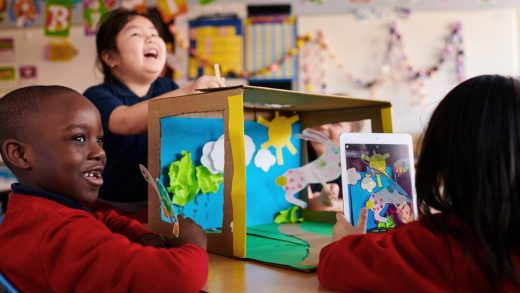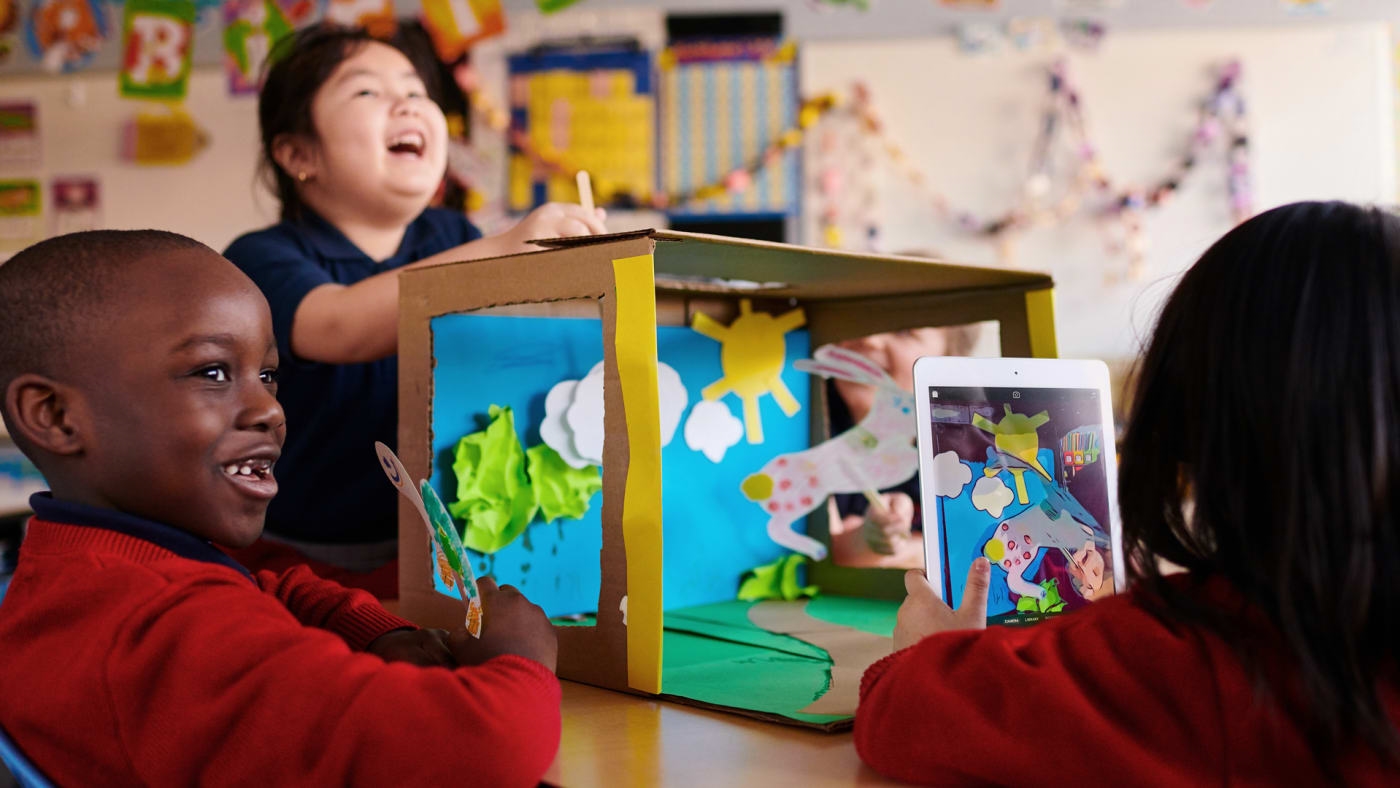Apple’s New Approach To Education Is Humbler, But Stronger
After the presentation at Apple’s education event in Chicago on Tuesday, I bumped into a senior Apple executive whom I’ve known for a long while. I was so happy about the classroom role Apple had defined for itself during the morning’s keynote that I gave him a Paul Hollywood Handshake.
For those of you who don’t watch The Great British Bake-Off–and what the hell is wrong with you, anyway?–this handshake is a dignified but powerful acknowledgment that the recipient has met or exceeded the giver’s expectations almost across the board. I didn’t have to explain it to the exec, as he was familiar with the show … once again confirming that Apple is on the ball.
Before I explain why I was in such a good mood, let’s deal with the sour stuff. If you were hoping that Apple would unveil new hardware, software, and strategy that would allow iPads to compete with Chromebooks toe-to-toe for classroom market share … well, that did not happen. It seems like an unrealistic goal to begin with. The market for classroom computers, software, and services is unique and somewhat bizarre, and Apple is uniquely ill-suited to compete in terms of raw market share. (One study said that Chromebooks had 60% of the K-12 market in the U.S. last year; iPads and Macs took 15% between them.)
A school system needs computers to be inexpensive, so they can buy as many as they need. Teachers and admins need to have the power of an Old Testament God over the hardware and software. They need open systems that can be customized, automated, and controlled. School computers need to be built like Soviet washing machines, so that they can absorb many Gs of dropping force and many ounces of spilled milk and keep right on going. If a computer does break, the school needs to pop off the plastics and fix it, using available parts.
Schools want to shop from among multiple suppliers, for competitive bids and better pricing, and to choose hardware that’s the best match for their particular needs. A couple of years after they buy these machines, the school needs the option of reconfiguring them (perhaps even with a whole different operating system) to pursue educational goals that didn’t exist when the school first bought them.
Overall, does this sound anything like any kind of device Apple is interested in–or even capable of–making?
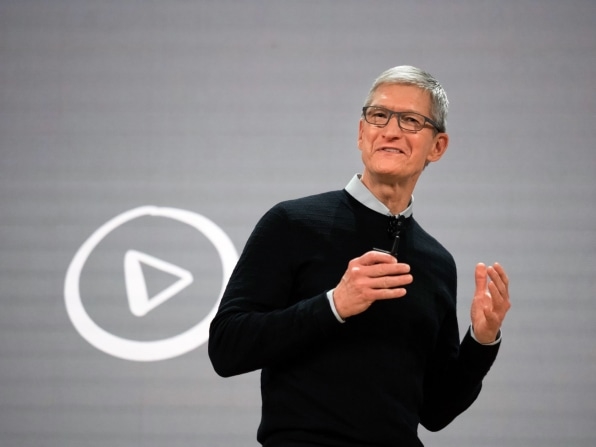
Stacked Deck
Even if Apple is up for it–and judging from its Chicago unveilings, it sure seems to be–the educational deck is stacked against the company. It can’t possibly design and build iPads in enough configurations and styles to satisfy the individual needs of so many school systems and it’s never going to license other companies to handle the job. Consumers will adapt to design bummers like “no headphone jack on the iPhone” or “MacBook Pro keyboard that’s only a slight improvement over typing on a grid of squares drawn on a paper towel.” Schools can’t. They shouldn’t. Each one’s needs are different, and hammering hardware and software into the best shape and consistency to best serve their students is a big part of teachers’ and IT departments’ jobs.
iPads are often aced out of a school simply because of hardware standards defined and required by a core curriculum. Honestly, I could have just written “iPads don’t have keyboards” and rested my case. It doesn’t matter that an iPad’s touch and Apple Pencil input are more interesting and maybe even more powerful than a laptop keyboard. It’s a different culture. Schools overwhelmingly insist that the HAL-9000 from 2001: A Space Odyssey isn’t really a computer. They say it could become one if somebody attached a keyboard to it. The goals of educating kids on computers include getting them to write with keyboards.
“Big deal,” you say. “I use a Bluetooth keyboard with my iPad all the time.” Ah. But it’s an extra expense. And many schools won’t accept them. Clever kids can use wireless keyboards to swap answers with each other during exams. I told you: education is a whole different world.
Well, I’ve already brought myself down so why not pile on some more: it’s way easier to find and hire staff who know how to administer and develop apps for Chromebooks than iOS devices using Apple’s way-less-popular classroom and school management tools.
Despite all these ugly realities, Apple used its Tuesday event to clearly explain a comprehensive and well-considered plan for the value that iPads and Apple software could add to education. There was none of the (dare I say) jaunty 1800s missionary “meet your new god” swagger that I sensed in the earlier “iPads for schools” push. Apple certainly didn’t say “Chromebooks are a huge success in education because they’re practically perfect for that world,” but it seemed to acknowledge that reality.
Apple’s new stance seems to be that kids can interact with iPads in ways that are unique. iPads have a point of view on education. And while not every school–or even most of them–can choose the iPad as its classroom computer, Apple is motivated to remove every obstacle that it can, making the experience as valuable as possible for the kids who use them and the educators who help the kids.
It’s a familiar vibe from Apple. Its aspiration isn’t market share. It’s profitability and delivering “best experience” for their users. On that basis, Apple thinks it’s okay for Macs to own just 12% of the desktop market so long as those 12% of users are way, way happier with their Macs than the users in that much larger part of the pie chart are with their Windows machines.
Apple’s customers have self-selected as people whose needs (or even just desires) aren’t being met by the market leader. Give them special attention and scratch them behind the ears, and they’ll be loyal customers.
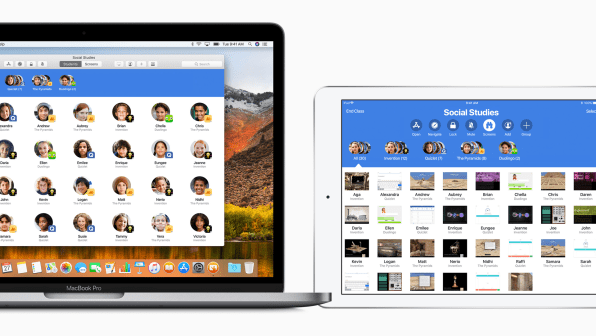
The iPad’s strengths in an educational setting aren’t far afield from those it offers consumers. Has Apple ever done an iPad commercial with people using spreadsheets? Naw. The ads are about this compact mobile device that you can use to make drawings, photos, 4K videos, and handwritten notes. A Chromebook is a compact, durable notebook, but its personality is still consistent with a desktop: you sit down before it, as if it were a piano. An iPad, by contrast, enters your personal space. It’s in your hands as you stand and write notes, or it lays flat on the table during a meeting, instead of interposing itself between you and the room like a Battleship game.
All of this came through during Apple’s event. The onstage presenters were eager to show off iPad courseware, sure, but Apple seemed to want to present an image of kids taking iPads out into the world, coming back with notes and pictures and videos, and then building presentations so that they could share what they saw and learned with the rest of the class. You can do all of that with Chromebooks–or Windows laptops–but it’s not quite the same and Apple can do it way better.
The iPad’s advantages as a personal creativity tool remain irrelevant if Apple doesn’t have the features whose absence educators consider a dealbreaker. Apple’s new software, services, and features address many (or maybe even most) of the important complaints that educators have shared with me about iPads in the past month. Classroom iPads are now multiuser. A kid can grab any iPad off of a rack, tap the picture of his or her face, enter a passcode. After a brief wireless interlude with the cloud, this random device will be restored to the state the kid left another random iPad in at the end of (April 15, 2018)’s class. Admins can set up new devices and new students in bulk, and do it fast. They have the power to create Apple IDs (which link students with their individualized apps and creations, as well as identifying them for messaging) on the fly and remove them just as easily. The same cart of iPads can be completely reconfigured for a different classroom’s needs in less time than it takes to wheel it from the art room to the physics lab.
A teacher at the front of the room is armed with the full range of supernatural power over a class’s iPads. When guiding a lesson, he or she can make every device open the same content in the same place, while simultaneously locking all of those iPads down so that the kids can’t do anything except turn the pages and read along as directed. When the lesson is complete, the teacher can have the kids’ iPads launch into the proper assignment in an interactive workbook. While they work, the teacher’s iPad can show an overview of the kids in the class, revealing in interactive detail the progress each of them is making in the assignment. If a couple of kids seem to be making heartbreakingly slow progress, the teacher’s iPad can dive deeper, revealing where they’re having trouble and comparing performance with previous assignments as well as with the performance of the rest of the class, making it easy to single out the students who need extra attention.
There’s much more, of course, but that gives you an idea of how much Apple has benefitted from talking with educators—and from hiring many teachers who have added their battle-won insights to the mix.
Last year, when Apple released the first 9.7? iPad ($299 for education-only pricing; for us civilians, it’s $329), it was notable in and of itself. It’s not as cheap as a cheap Chromebook, but it’s in the same ballpark (in a box seat, behind the dugout). The 2018 edition has the same price and appears to be physically identical, but it’s a milestone product.
Unlike last year’s model, there’s nothing about the new iPad that telegraphs “budget iPad.” The screen is retina-quality and lovely; if I wanted to be a party pooper, I would point out that the display isn’t laminated at the surface of the glass, as with premium iPads. That would’ve been nice; it sells the psychological illusion that you’re directly interacting with what you see on the screen.
But who cares? The only tip-off comes when you’re writing or drawing with an Apple Pencil; the tip floats a millimeter or so over the pixels. It doesn’t affect drawing or writing in the least.
Heck yeah, this $299 tablet works with the $99 Apple Pencil! Every Pencil app for the iPad Pro will operate on this tablet that costs a third as much. The processor has been bumped to Apple’s A10 Fusion, the same as the iPhone 7’s. During my time with a demo iPad, I tried furiously to get it to drop frames or stutter or choke in any way. But nothing doing. It still felt as fluid as my 12.9? iPad Pro.
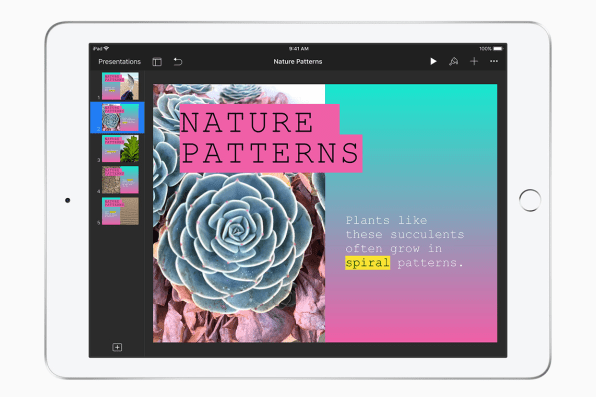
Whither The Educational Mac?
The new iPad’s hardware upgrades will be a big help in education. The fast chip means the cheap iPad can handle augmented reality scenes with as much grace as any other model, and the Pencil puts it on an equal level as a creative tool. But I’m pleased with this new tablet for a different reason. My big disappointment with Apple’s hardware lineup has always been its apparent “No Poors Allowed” message. Great technology is useless to people who can only admire it academically … and I keep chewing on the question “If a great company lacks the desire or the skill set to create brilliant, beneficial technology to everybody, can I truly think of them as great?”
I’d still love to see Apple develop a $400 desktop Mac or a $600 MacBook. The Mac Mini–Apple’s affordable desktop Mac — has been ignored for years. Has Apple already canceled the product, and just not told anybody? Consumer-grade iMacs haven’t received much love, either. Apple won’t even sell you a MacBook with a straightforwardly conventional keyboard and array of ports if you don’t want the MacBook Air. It’s a lovely notebook, but in 2018, it looks like a crashed Cold War bomber that’s just been regurgitated by retreating Arctic ice.
But though the $299 iPad isn’t as broadly useful as a good notebook, its feature set is so far beyond its price point and are so empowering to the user that I’ll grant Apple a mulligan. If the company wants to respond to the question “What about a budget Mac?” by pointing to the $329 general-consumer Pencil-compatible 9.7? iPad, I’ll sign off on that choice.
In the end, the Chicago event confirmed a longstanding belief of mine. During a public presentation, Apple is completely unable to fake any excitement about a product that it couldn’t care less about. Like, any Mac whatsoever that’s not powerful enough to build software for iOS devices. “We love the Mac,” the Apple executive who drew the short straw backstage sighs. “It’s still a tremendous focus of our passion and interest. And to prove it, I’d like to show off a new stickers feature we’re adding to the Mail app.”
But in the same way, Apple is also unable to conceal its delight in a product that it’s truly excited about. Like a new iPhone. Or the HomePod. Or—most relevant right now—its educational ecosystem and the entry-level iPad that will serve as that ecosystem’s hardware backbone.
The company didn’t turn its education offerings around on a whim. What we saw on Tuesday required years of research, assessment, reflection, reinvention, and hard work. That’s the kind of effort that the company puts into a product line that it finds exciting.
Education feels like it’s as deeply rooted in Apple’s DNA as research is in Google’s. The sounds of all of those Apple IIs booting up in school libraries back in the ’70s and ’80s continue to reverberate throughout the halls of Apple’s new headquarters. And if at times–all right, maybe even for years on end–that sound has been distressingly faint, it generates a resonant frequency in Apple’s collective consciousness.
It’d be a damn shame if Apple ever stopped wanting to be a uniquely positive force in education. An unequivocal sign of commitment like the show it put on Tuesday comes as a relief.
“Andy Ihnatko is a veteran technology journalist. He is also the longtime co-host of the MacBreak Weekly podcast on the the TWiT network and a regular contributor to WGBH Boston radio.
(25)

